Big Base DBA (also known as Big Base De Bellis Antiquitatis or BBDBA) allows fast games with a small number of playing pieces and lots of figures. Big Base DBA requires few modifications from the standard DBA rules.
Inspired by Philip Sabin’s Analysis of Ancient Warfare in Lost Battles I’ve drifted further away from normal DBA than you need to, but I’ll explain why as I go along. Mostly it affects basing.
Basing for Big Base DBA
The big change is, not surprisingly, the bases. Big Bases.
Roughly speaking my Big Bases are the same size as an Impetus base. This makes them four times the area of a normal DBx or Field of Glory base.
The number of figures is up to you but I have followed Impetus and used a lower density of figures than DBx and Field of Glory use. There are four reasons for this:
- economy – 25% to 50% less figures per base means cheaper or, because I have the figures and I’m just rebasing, it means I get more bases for my money.
- aesthetics – impetus players, for example, try to make each base a mini diorama. I’m not so flash but try.
- figure insurance – the more space around the figures, the less they get handled/bashed, the longer they last.
- I just followed what the Impetus players do – the lower density looks normal to them.
I, like Philip Sabin, follow ancient authors who only divide infantry into heavy and light. Similarly cavalry is divided into heavy and light. I have adopted a basing style that reflects that simple division. Elephants and Chariots are different.
That means I only have two base sizes. Foot are on 80mm wide and 40mm deep bases. Mounted on 80mm wide and 60mm deep.
Heavy Cavalry
All of my Big Base DBA mounted bases are 80mm wide and 60mm deep. Each Heavy Cavalry stand – Knights, Cavalry, Camalry – gets six mounted figures – six men and six mounts. This is 50% of the troop density you would have in a game like DBx or Field of Glory but matches what people use for Impetus.
With quite a big base for the number of figures I have quite a lot of choice for how to base the figures. My Seleucid (or any Macedonian) cavalry are based in wedge.


My Gallic Noble cavalry are based in a single line.


My Iberian cavalry are based in an irregular pattern. §



Light Cavalry
My Light Cavalry, like all mounted, are on 80mm wide and 60mm deep bases. As with light infantry I put 4 figures on a base. This is 50% of the DBx / Field of Glory figure density


Heavy Infantry
Each of my infantry bases is 80mm wide and 40mm deep. I put 12 figures on most heavy infantry elements, whether Spearmen, Blade, Auxiliary, Warband, Pike or Bow. Six figures in each of two rows for the more regular types. This is 75% of the troop density you would have in a game like DBx or Field of Glory but is what you see on Impetus stands. To my eyes it gives a good sense of mass but leaves some gaps around the figures to allow handling of the bases.
Spearmen
I base Spearmen in two rows of six. This is in no sense a shield wall, more a bunch of guys standing next to each other. But locked shields are not possible with most figures.


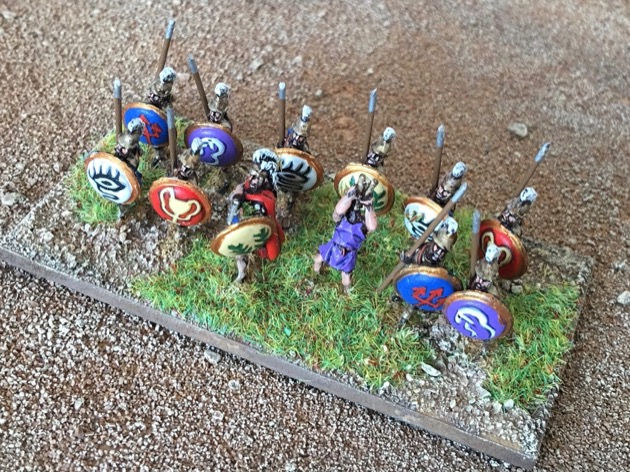
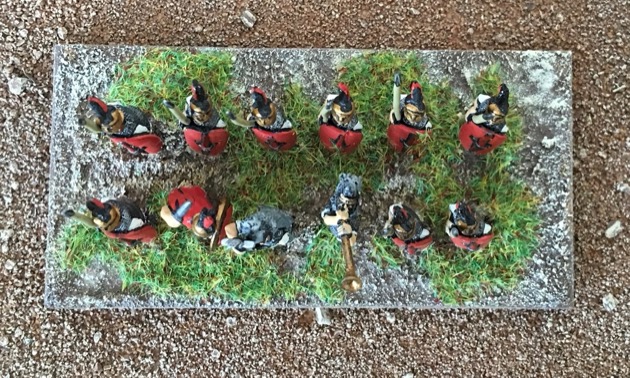

Blades
Regular blades go in two rows of six figures.



Rather than the DBx convention of having irregular Blade as a lower density of figures (3 to a base rather than 4) I give my more irregular types a more irregular basing pattern. For example, I based my Thracian Rhomphiamen as a wild mass.

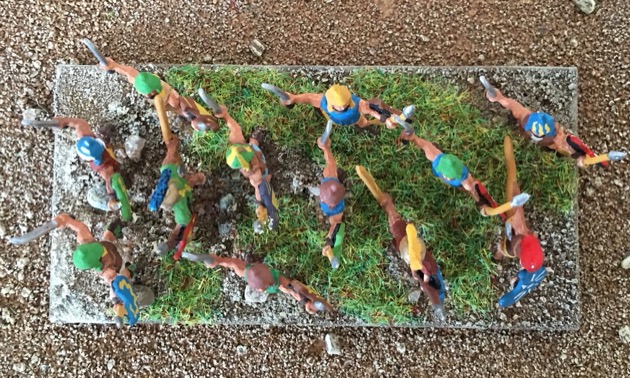

Auxilia
I’m not a big supporter of Auxilia as a troop type but they are a mainstay of many of my DBA armies. I base them like the rest of the heavy infantry. Generally two slightly irregular rows of six.





Warband
Again I’m not a fan of DBA’s Warband type so these guys just get based as normal heavy infantry, i.e. two rows of six. I ignore the DBx convention of 3 figures per base for loose formation warband and 4 figures for close formation – this is not a distinction I believe in.


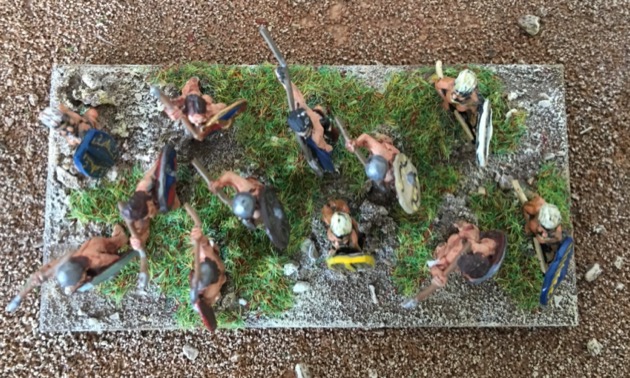

Pikes
For Pike elements I want to suggest more depth without using significantly more figures. After much soul searching I’ve gone for 15 figures split over three rows, 15 figures total. One base looks fairly solid.


Two bases look very solid. A two element Pike block has 30 figures, with the figures in five files and six ranks.


Light Infantry
Psiloi in Big Base DBA are on my normal 80mm wide and 40mm deep infantry stands. But to show they are light infantry I only put four figures on the base. This is 50% of the DBx / Field of Glory figure density. But it looks alright to my eyes.





Chariots
I put Chariots on my normal mounted bases (80mm wide and 60mm deep). However, I put two chariots on each base.

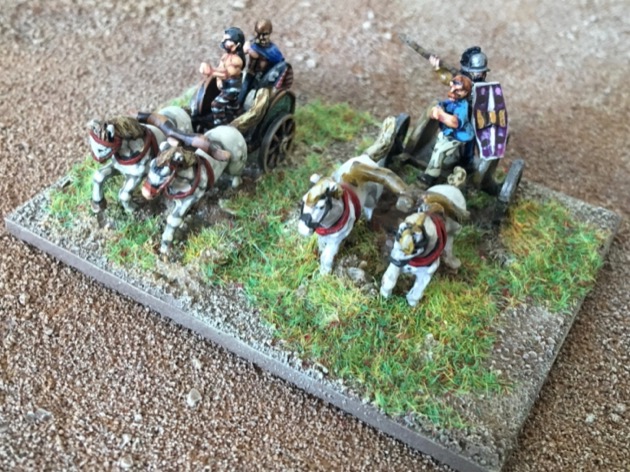
For my biblical armies I’ve put chariot runners as escorts on the base, one per chariot, so two per base. For chariots with three crew in the chariot, e.g. some Hittite models, I assume the third man is a chariot runner and so don’t put a foot figure on the base.
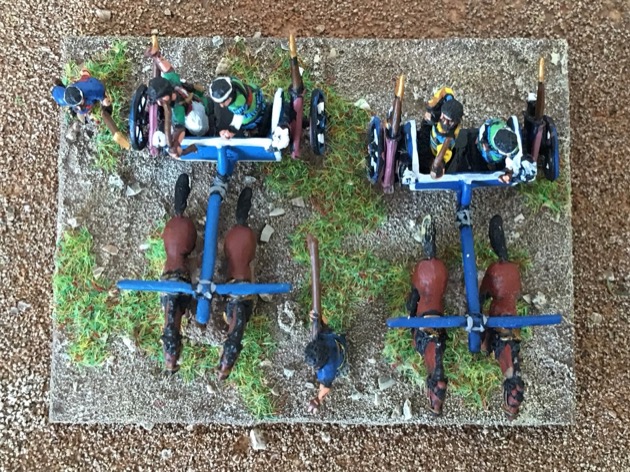
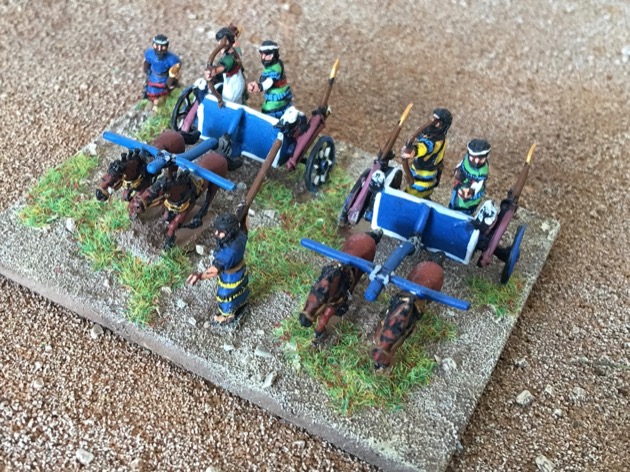

Elephants
Again I put put my Elephants on 80mm wide and 60mm deep mounted bases. Again Philip Sabin creeps into my thinking. So elephants, whether African or Indian, can be accompanied by light infantry escorts or unaccompanied. For escorted elephants I put one elephant model on a base with thee light infantry escort figures. For unaccompanied elephants, representing massed elephants, I put two elephant models on a base.


Camps
My big base camps are 120mm wide x 80mm deep.



but you can see the Egyptian camp in the background
Wow that is big
Bigger bases means a bigger table and longer pace.
4′ x 4′ Table
To accommodate the bigger bases I’ve used a 4′ x 4′ table rather than the normal 2′ x 2′ table.

A pace takes you further
All distances have to increase accordingly. So in Big Base DBA 1″ = 50 paces i.e. 100 paces = 2″.
Big Base Barker Markers
And I thought I’d make some Barker Markers on Big Bases.



Good stuff! Has given me something to think about in how to base my El Cid forces for 1 Hour Wargames (and now for BBDBA as well).
Best regards,
Chris Johnson
By chance I was intending to give 1 Hour Wargames a go this week. Using Big Bases of course.
Those look ace!
Thanks Rich. You can always pop over for a game. 😉
Over 3 decades ago, I was ordering 6mm Napoleonics.
There was a big discount on offer for spends above a certain threshold.
I topped the order up with some ancients.
I soon learned that mounting the figures on half dimension 15mm bases (20mm wide and 7.5, 10 or 15mm deep) – suggested I think in the Nth edition WRG rules was a route to total madness.
used 15mm base sizes and packed in 4 times the recommended figure count (and, like yourself tripled the ranks for Pikes).
The infantry looked great.
The hard lesson of the first attempt was that 2 ranks of horses look daft where the front rank’s tails are touching the rear rank’s noses.
Since then I’ve been doing a single rank of mounted.
The real test was “How am I going to paint that many figures” (Imagine a WRG Gallic army with 200+ bases of 12 man warriors).
With mass approach painting it can be done, but it’s a chore.
Fortunately DBA was published the following year, and my base requirements returned to sane quantities.
The very few 6mm figures I’ve got are based 16 infantry to a 40mm x 20mm stand. Or 12 British infantry and a battalion gun. Or 8 cavalry. So we did something similar is appears.
My Big Base DBA is moderately sane/insane depending on your perspective. 12 stands of 12 figures gives a maximum of 144 figures in an army, ignoring options. The more cavalry or skirmishers in there the less the total number of figures. Okay, that is three times the number of figures of a normal size DBA army but still less than you’d need for DBM, DBMM, Field of Glory, etc.
Spending Christmas rebasing- love this idea. Cardiff gaming will be revolutionised!
Mike B
Despertaferres.wordpress.com
In general it looks good, especially for the lighter troops, though hoplite troops standing in loose order looks odd, and it is weird to have issues with Auxilia and Warband (legitimately) but accept Pike as a distinct class of troops without question.
Robert, in general I find combat poses tricky for wargaming figures because the figures take up more space than the actual men did. Hoplites suffer from that problem so it is hard to get locked shields with wargaming figures. Hoplites have the added issue that the only combat poses are with arm overhead, and I don’t believe that is how they fought. I find Christopher Matthew’s argument, in “A Storm of Spears”, quite compelling; he argues hoplites fought underarm. These challenges leave me depicting my hoplites at ease. Other folk can, of course, chose a different path.
Are you suggesting that Pike are indistinguishable from other ancient combatants? That seems unlikely given the material that has come down to us.
late to the party here Steve. I am doing a whole series of armies in 10mm and am trying to get the ‘best fit’ bases for use with a whole range of rulesets. I like what you have done here re your choices and spacing etc. I have been pondering the use of a standard base (in this case 40 x 20 and 40 x 30) for 10mm and then sabots for bigger looking units
I am also very much in agreement with you re warband and auxilia as troop types….they just dont fit and with DBA 3 there is no reason why you cant differentiate using fast and solid on the other foot types